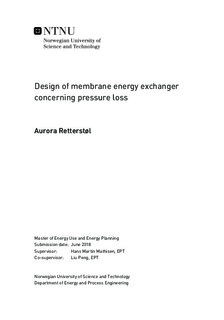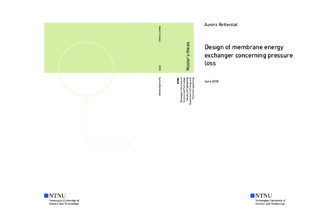| dc.description.abstract | The world is facing climate changes that will have great influence on the ecosystem if changes are not being made. The building sector accounts for a great share of the total energy use in Norway and has therefore the possibility of being significantly reduced. An effect of this is shown in the building regulations where the requirements are getting stricter. The requirements for the ventilation system are also getting more rigorous, and therefore the choices concerning the components selected in the AHU must be deliberately selected.
Compared to a conventional heat exchanger, a quasi-counter membrane energy exchanger can recover sensible and latent heat, whereas the efficiencies have been proven to be sufficient in cold climates. Beneficially, the MEE obtains freezing problems occurring at a lower temperature. To keep the membrane from moving, spacers are inserted into the channels, which will be retaining the channel height. However, the pressure drops for a MEE increases compare to a flat plate heat exchanger due to the use of spacers. Therefore, the present thesis executed a theoretical and experimental pressure drop investigation for the MEE and the spacers. The pressure drop was measured under isothermal conditions, whereas the heat and moisture transfer were neglected.
According to the evaluated spacers, six different spacers were inserted into a test rig, were the pressure drop was measured for different airflow rates. The experimental investigation included different dimensions of the mesh screens as well as varying corrugation pitches.
The results gave that the corrugation pitch of the spacers had little influence on the porosity, whereas the mesh dimensions seemed to affect the most. In addition, both corrugation pitch and porosity influenced the pressure drop. Yet, the dominating contributor ensuring the lowest pressure drop could not be obtained by the study conducted in this thesis. Further, the experimental pressure drops results showed great promises for the tested spacers. The most promising spacer obtained the lowest pressure drop of 52 Pa when the average velocity was 1~m/s through the counter flow area. In addition, the most promising spacer was also the most porous tested spacer.
According to other studies, the spacers showed great potential of reducing the pressure drop through spacer-filled channels. The airflow rates selected for evaluation were based on the lower pressure drop this would enhance. To obtain larger velocities inside the channels, experimental testing must be conducted for the respective airflow rates. However, the pressure drop seems to still enhance low pressure drops compared to other studies.
Different geometries of the spacers were conducted, but the ability to keep the membrane steady and from deflection could not be obtained be the executed investigations.
When the pressure drop for the MEEs are being reduced to the approximate same values as for heat exchangers utilized in residential buildings and the efficiency has been proven to be significant in cold climates, the MEE has a great potential for substituting the conventional flat plate heat exchanger in AHUs. | |

